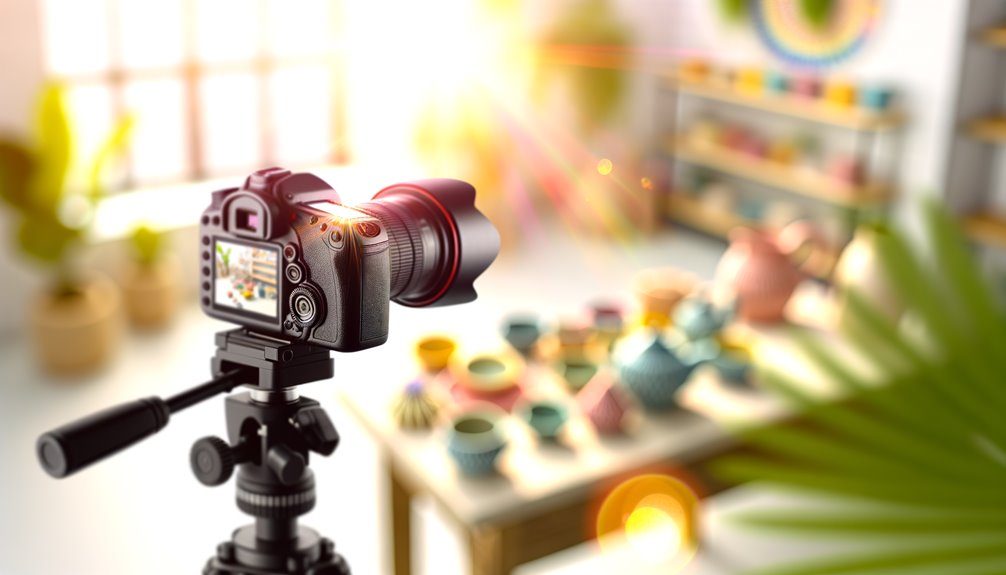
High-quality images are essential for any website aiming to attract and retain visitors. They convey professionalism and enhance user experience. Investing in the right equipment and mastering essential techniques can greatly boost visual appeal. Additionally, effective lighting and careful editing play important roles in creating stunning photographs. Understanding these elements can transform a website’s aesthetic. Nonetheless, the journey doesn’t end there; several other factors must be considered to truly optimize your visual content.
Key Takeaways
- Invest in quality equipment, including cameras and lenses, to ensure high-resolution images for your website.
- Master lighting techniques, utilizing natural light or artificial sources, to enhance the mood and clarity of your photos.
- Edit and optimize images by correcting colors and compressing files to improve loading times without sacrificing quality.
- Incorporate branding elements consistently in your photos, such as color palettes and logos, to reinforce your brand identity.
- Organize your photo library effectively using tags and folders to streamline retrieval and maintain a cohesive visual experience.
Understanding the Importance of High-Quality Images
High-quality images serve as the visual backbone of any website, playing an essential role in capturing visitors’ attention and conveying professionalism.
The impact of image quality is significant; it directly influences user engagement and trust. High-resolution photos create a compelling narrative, enhancing visual storytelling that resonates with an audience yearning for freedom and authenticity. Additionally, professional web design correlates strongly with business success, making quality images even more crucial to a website’s overall effectiveness.
Each image acts as a window into the brand’s essence, inviting exploration and connection. In a digital landscape saturated with mediocrity, investing in superior imagery not only distinguishes a website but also raises its comprehensive perception, fostering a lasting relationship with its viewers. Additionally, a professional website design improves search engine rankings, which can further amplify the reach of high-quality images and enhance overall brand image.
Choosing the Right Equipment for Photography
Selecting the right equipment is vital for achieving high-quality photographs that enhance a website’s visual appeal.
Understanding the various camera types, choosing the appropriate lenses, and recognizing the importance of lighting equipment are essential steps in this process.
Investing in the right tools not only improves image quality but also empowers photographers to capture their vision effectively.
Camera Types Overview
Choosing the right camera can greatly impact the quality of photos for a website. Understanding various camera types is essential for anyone looking to enhance their visual storytelling. A camera features comparison can help in selecting the ideal model that suits both needs and budget. Below is a concise overview of popular camera types, aligning with current photography trends:
| Camera Type | Key Feature | Ideal For |
|---|---|---|
| DSLR | Interchangeable lenses | Professional use |
| Mirrorless | Compact size | Travel and versatility |
| Point-and-Shoot | User-friendly | Casual photography |
Selecting the right camera empowers creative freedom.
Essential Lens Selection
The right lens can greatly enhance the quality of photographs, transforming an ordinary image into an enchanting visual story.
Selecting appropriate lens types and understanding focal lengths are essential for achieving desired effects. Wide-angle lenses invite a sense of space, perfect for landscapes or interiors. Conversely, telephoto lenses excel in capturing distant subjects with clarity, ideal for portraits and wildlife.
Additionally, prime lenses offer superior sharpness, while zoom lenses provide versatility. By choosing the right lens, photographers can release their creativity, capturing striking visuals that resonate with their audience, ultimately elevating their website’s aesthetic appeal.
Lighting Equipment Importance
While a skilled photographer can create stunning images, the importance of proper lighting equipment cannot be emphasized enough.
Effective lighting techniques, whether natural or artificial lighting, transform ordinary scenes into enchanting visuals. Investing in high-quality lighting gear allows photographers to manipulate shadows and highlights, enhancing texture and depth.
The right equipment can uplift a composition, ensuring that the subject shines through. For those who cherish creative freedom, understanding and utilizing lighting is essential.
It empowers them to craft unique atmospheres and evoke emotions, ultimately leading to high-quality photos that resonate with viewers and enhance their website’s appeal.
Mastering Basic Photography Techniques
Mastering basic photography techniques lays the foundation for capturing stunning images that enhance any website.
Understanding framing techniques is essential; it allows photographers to create visually appealing compositions that draw viewers in. By strategically placing subjects within the frame, one can evoke emotion and tell compelling stories.
Additionally, mastering exposure settings guarantees images are neither too dark nor too bright, striking the perfect balance for clarity and detail.
The Role of Lighting in Capturing Stunning Photos
Effective lighting serves as the cornerstone of stunning photography, elevating images from ordinary to extraordinary. Utilizing natural light during the golden hour can infuse warmth and depth into photographs. Alternatively, artificial lighting allows for controlled environments, enhancing shadows effects and color temperature. Various lighting techniques, including backlighting effects and ambient light, can evoke emotion and create drama. Employing light modifiers optimizes brightness and reduces harshness, while thoughtful lighting setups enhance composition. The following table summarizes essential lighting concepts for capturing enchanting photos:
| Concept | Description |
|---|---|
| Natural Light | Available sunlight, varies by time |
| Artificial Lighting | Man-made sources, like strobes |
| Golden Hour | Soft, warm light shortly after sunrise or before sunset |
| Shadows Effects | Enhances depth and texture |
| Light Modifiers | Tools to diffuse or direct light |
Composing Your Shots for Maximum Impact
How can the arrangement of elements within a photograph transform an ordinary image into a compelling visual story?
Mastering composition is essential for creating impactful photos. Effective framing techniques and strategic focal points guide the viewer’s eye and evoke emotion.
Consider these three approaches:
- Rule of Thirds: Divide the frame into a grid and position key elements along the lines or intersections.
- Leading Lines: Use natural lines to direct attention toward the focal point.
- Negative Space: Emphasize the subject by surrounding it with empty space, allowing it to breathe.
These techniques enhance visual storytelling, inspiring freedom in creativity.
Editing Your Photos for Professional Results
Editing transforms raw photographs into polished, professional images that captivate viewers. Employing techniques like color correction and photo retouching not only enhances visual appeal but also communicates brand quality. By refining your images, you create a cohesive look that resonates with your audience’s desire for authenticity and freedom.
| Technique | Purpose | Tools |
|---|---|---|
| Color Correction | Adjust hues and tones | Lightroom, Photoshop |
| Photo Retouching | Remove imperfections | Photoshop, GIMP |
| Cropping | Improve composition | Various software |
| Sharpening | Enhance details | Lightroom, Photoshop |
Optimizing Images for Web Performance
Optimizing images for web performance is essential for enhancing user experience and site speed.
By employing effective image compression techniques and selecting the appropriate file formats, website owners can greatly reduce loading times while maintaining visual quality.
This strategic approach not only improves site performance but also positively impacts search engine rankings.
Image Compression Techniques
Mastering image compression techniques is essential for enhancing web performance and ensuring a seamless user experience. By implementing effective methods, website owners can improve loading times while maintaining visual quality.
Key strategies include:
- Lossless Compression: This method reduces file size without sacrificing image quality, ideal for logos and graphics.
- Lossy Compression: This technique greatly decreases file size by removing some data, making it suitable for photographs where minor quality loss is acceptable.
- Utilizing Compression Tools: Various online tools can automate the process, saving time and effort while achieving excellent results.
Embracing these techniques empowers creators to enhance their online presence.
File Format Selection
Choosing the right file format for images can greatly influence web performance and user engagement. When deciding between JPEG vs PNG, one must consider file size and quality.
JPEGs are ideal for photographs, offering smaller file sizes that enhance loading speeds without sacrificing clarity. Conversely, PNGs excel with graphics requiring transparency and sharp edges, though they often result in larger files. Utilizing SEO techniques to optimize image sizes can further improve page load times.
Balancing image quality with file size considerations is essential; a website that loads quickly keeps visitors engaged and encourages exploration. Additionally, a well-designed website boosts credibility and increases user engagement, which can lead to higher conversion rates. By making informed choices in file format selection, webmasters can create a visually appealing and efficient online presence.
Incorporating Branding Elements Into Your Photos
While many photographers focus solely on composition and lighting, integrating branding elements into photos greatly enhances a website’s identity and appeal.
This approach fosters brand consistency and amplifies visual storytelling, effectively engaging audiences. To achieve this, consider the following:
- Color Palette: Utilize your brand’s colors to create harmony and recognition.
- Logo Placement: Subtly include your logo in images to reinforce brand identity without overwhelming the visual.
- Thematic Elements: Incorporate items or settings that reflect your brand’s values and mission, creating deeper connections.
Utilizing Stock Photos and When to Use Them
When businesses find themselves in need of high-quality imagery but lack the resources to produce original content, utilizing stock photos can be an effective solution. Stock photo sourcing offers a vast library of visuals, ensuring that brands maintain an appealing online presence without compromising quality. Nevertheless, it is essential to prioritize ethical usage to avoid legal ramifications and support artists.
| Photo Type | Best Use Cases | Ethical Considerations |
|---|---|---|
| Royalty-Free | General website imagery | Purchase licenses |
| Creative Commons | Non-commercial projects | Give appropriate credit |
| Premium Stock | High-end branding | Follow usage guidelines |
| Free Stock | Budget-friendly options | Verify copyright status |
Keeping Your Photo Library Organized and Accessible
A well-organized photo library is essential for any website aiming to deliver a professional and cohesive visual experience.
Effective photo management facilitates quick access to images, allowing creators the freedom to focus on their design intentions.
To achieve this, one should consider the following:
- Categorization: Sort images into folders based on themes or projects for easy retrieval.
- Metadata: Utilize tags and descriptions to enhance searchability within digital storage systems.
- Regular Maintenance: Periodically review and delete outdated or irrelevant photos to keep the library streamlined.
Frequently Asked Questions
How Do I Choose the Right Location for My Photos?
Choosing the right location requires thoughtful location scouting, considering both aesthetic appeal and practical elements. Ideal lighting conditions enhance visual impact, empowering creativity. A well-selected site can raise the overall quality and storytelling of the photos.
What Are the Best Practices for Photographing Products?
The optimal methods for photographing products include mastering lighting techniques to enhance details and selecting background choices that complement the product, creating an engaging visual narrative that resonates with viewers and raises their perception of the items.
How Often Should I Update My Website Photos?
Regularly updating website photos enhances photo freshness and engagement. Experts recommend seasonal updates to reflect changing trends and maintain relevance, allowing businesses to connect authentically with audiences and express their evolving identity and offerings.
Can I Use Smartphone Photos for My Website?
Smartphone photography can be a powerful tool for website imagery. With proper image editing, these photos can achieve impressive quality, offering a cost-effective solution for those seeking creative freedom and visual appeal in their online presence.
What File Formats Are Best for Website Images?
Choosing the right file format is essential. JPEG offers compression advantages for photographs, while PNG benefits include transparency and lossless quality. Selecting the appropriate format empowers creators to enhance visual impact and user experience effectively.
Conclusion
To sum up, investing time and resources into high-quality photography is essential for any website aiming to captivate its audience. By understanding equipment, mastering techniques, and harnessing the power of lighting and composition, businesses can create images that not only attract attention but also reinforce their brand identity. Coupled with effective optimization and organization, these images become invaluable assets, driving engagement and fostering trust. Elevating your visual content is not just an option; it’s a necessity for online success.

WordPress-6-6-Squished-Image-Hotfix
A must-have for WordPress users, the 6.6 Squished Image Hotfix resolves critical image issues—discover how to keep your visuals pristine and engaging.

Attract-More-Patients-To-Your-Website-With-Photos
Unlock the potential of your healthcare practice's website with captivating photos that draw in patients—discover how to elevate your visual appeal now.
